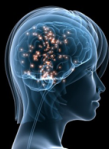Teenager with Persistent Headache, Irritable Mood, and Weight Gain

A 14-year-old girl presents with near constant frontal headaches of a month’s duration. The pain is dull and worsens with Valsava’s maneuver. Her parents say she is she is irritable and moody. The patient says she has recently gained a significant amount of weight. Eye examination reveals papilledema. CT imaging of her brain is normal.
New onset continuous headache is an uncommon symptom in childhood and warrants thorough neurologic and ophthalmic examinations. It is notable that the patient’s headaches worsen with activities that raise intracranial pressure. The alteration in mood and personality and weight gain may suggest depression-a comorbidity commonly associated with migraine headaches and chronic pain syndromes. The presence of papilledema, however, makes this case a neurologic emergency.
What tests would you order to reach a diagnosis?
Answer and Discussion on Next Page
Answer and Discussion
Alone, CT imaging of the brain may not provide sufficient information for a diagnosis because it does not allow good visualization of the posterior fossa. If a tumor is strongly suspected, contrast-enhanced CT is a reliable test, particularly if MRI testing is not conveniently available although MRI remains the preferred imaging modality.
A spinal tap was performed with the patient in the left lateral decubitus position with her legs extended. Opening pressure was 45 cm H2O. MRI images and of the venous sinuses of her brain showed no abnormalities. A diagnosis of idiopathic intracranial hypertension (IIH; previously known as pseudotumor cerebri) was entertained. Modified Dandy criteria1 are used diagnose IIH. These include:
• Symptoms of raised intracranial pressure in an awake and alert patient, with normal imaging
• Elevated opening pressure on a spinal tap
• Exclusion of other conditions that could explain the raised intracranial pressure
Unfortunately, normative values for cerebrospinal fluid opening pressure have not been clearly established in children. Opening pressure may vary on the basis of body mass index (BMI): heavier children have higher values. Nonetheless, values greater than 25 cm H2O are considered elevated, regardless of BMI.
The cause of IIH may not always be clearly identified. In children, however, over half of cases may be associated with an identifiable condition,4 a number of which are well recognized. These include hypoadrenalism, iron deficiency anemia, Guillain-Barre syndrome, use of oral birth control, steroid withdrawal, and replacement therapy with human growth hormone.2,3
In adults, IIH is strongly associated with obesity;5 this association is tenuous in children, however, especially in prepubertal youngsters.6 Common symptoms besides headache, pulsatile tinnitus, and blurry vision include diplopia, neck stiffness, and symptoms referable to other cranial nerve palsies. The cardinal sign is papilledema.
It is important to document visual perimetry in every patient who can cooperate, because visual field loss may be asymptomatic initially, but it may worsen over time. Perimetry results can also guide treatment.7 Ocular coherence tomography has recently emerged as an objective method of assessing optic nerve involvement.
There are few randomized double-blinded, placebo controlled trials of treatment options for children. Medical management begins with lowering intracranial pressure with acetazolamide (doses of 250 mg twice daily to a maximum dose of 3000 mg/day) or topiramate (doses of 50 mg twice daily to a maximum of 200 mg/day). Headaches may not resolve as intracranial pressure decreases and prophylaxis with tricyclic antidepressants or beta blockers is often required.
Surgical options include shunting of CSF either with a ventriculoperitoneal shunt or lumboperitoneal procedure. Optic nerve sheath fenestration is also an option and should be strongly considered if vision loss does not respond to conservative measures.
The importance of weight loss for the child must be emphasized to the family. Prompt recognition and treatment of IIH leads to almost complete resolution of symptoms.8 Permanent complete vision loss is rare.
References:
References
1. Digre KB, Corbett JJ. Idiopathic intracranial hypertension (pseudotumor cerebri): a reappraisal. Neurologist. 2001:7:2–67.
2. Malozowski S, Tanner LA, Wysowski DK, et al. Benign intracranial hypertension in children with growth hormone deficiency treated with growth hormone. J Pediatr. 1995;126:996-999.
3. Mewasingh LD, Sekhara T, Dachy B, et al. Benign intracranial hypertension: atypical presentation of Miller Fisher syndrome? Pediatr Neurol. 2002; 26:228-230.
4. Youroukos S, Psychou F, Fryssiras S, et al. Idiopathic intracranial hypertension in children. J Child Neurol. 2000;15:453-457.
5. Rowe FJ, Sarkies NJ. The relationship between obesity and idiopathic intracranial hypertension. Int J Obes Relat Metab Disord. 1999;23:54-59.
6. Scott IU, Siatkowski RM, Eneyni M, et al. Idiopathic intracranial hypertension in children and adolescents. Am J Ophthalmol. 1997;124:253-255.
7. Wall M. Idiopathic intracranial hypertension. Neurol Clin. 2010;28:593-617.
8. Babikian P, Corbett J, Bell W. Idiopathic intracranial hypertension in children: the Iowa experience. J Child Neurol. 1994;9:144-149.